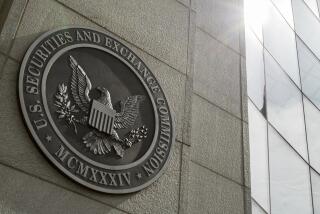We May See Less of Higher Price Spread
- Share via
It’s no secret that individual investors often face hefty transaction costs when buying or selling stocks, especially on the Nasdaq market. But does the same problem bedevil mutual funds that target small companies?
Stock-trading costs are a hot topic these days. The Securities and Exchange Commission recently adopted a new rule that will require complete disclosure of the prices at which stock orders are being placed. With better disclosures, the SEC hopes to discourage price fixing and enable investors to get better deals when buying or selling shares.
Specifically, the reform aims to narrow trading “spreads” by making order prices more visible.
A spread is the difference in price between what a dealer will simultaneously buy and sell the same stock. For example, a stock that a dealer will buy for $20 while selling for $20.50 trades at a spread of 1/2 point, or 50 cents a share.
Spreads, along with brokerage commissions, are two outlays all investors face when trading stocks. But mutual funds and other large-volume players get better deals than individuals. Fund managers can trade stocks for pennies a share, and they often can fill orders at prices better than those than retail investors receive--a situation known as “trading between the spread.”
One reason fund managers get better deals is that they have in-house traders working on their behalf, shopping among dealers throughout the day for the best prices. In addition, mutual funds have more negotiating power, in that they can offer the lure of additional orders for dealers who can fill trades at preferential prices.
The new SEC regulation, which will take effect near the end of the year, probably will narrow this edge by giving making it easier for retail investors to buy and sell at better prices when buying stocks on their own. Mutual funds also might do better.
“It’s the small guy who currently bears the brunt of the bad pricing,” says Tom Maguire, portfolio manager of the Safeco Growth Fund in Seattle. “Institutions can trade, and usually do, between the spread.”
But Harold Bradley, director of equity trading for Twentieth Century Mutual Funds in Kansas City, Mo., predicts the new regulation will spur “tremendous price competition” of which even funds can take advantage.
And he figures portfolio managers might be able to benefit in other ways. For example, one aspect of the new rule will allow funds to conduct more trades anonymously, helping to camouflage the kinds of big transactions that have the potential to sway prices.
“Anonymity is important because if a dealer knows we own, say, 10 million shares of Motorola and have started to sell the stock, that’s information that he can peddle to other customers,” Bradley says. Those customers might respond by cutting the price they will pay for Motorola stock, to the fund’s detriment.
Bradley says fund companies can buy or sell shares anonymously if they use “electronic communications networks”--nontraditional systems designed for institutions that disseminate price information and facilitate trading yet are neither exchanges nor brokerages.
Under the new SEC rule, orders in these electronic networks will be distributed to the broad public markets, providing more opportunity for funds to get anonymous trades filled.
Discussion of stock-trading costs and the new SEC rule can get complicated quickly. It’s perhaps sufficient to say that mutual funds receive better deals than individual investors and might benefit further from the SEC ruling.
Beyond that, it can be helpful to keep in mind the following generalizations on transaction costs:
* Mutual funds that own small, thinly traded stocks are most likely to face the fattest price spreads. It’s thus wise to examine a fund’s list of holdings in shareholder reports, says Michael Lipper of Lipper Analytical Services, a financial-research firm in Summit, N.J. The fewer companies you recognize, the higher a portfolio’s trading costs may be. Of course, small stocks may have other redeeming qualities, such as souped-up appreciation potential.
* Funds with high “portfolio turnover” face greater trading costs. This indicator measures buying and selling activity. The higher the number, the more transactions. Turnover of 100% implies that a fund’s manager holds each stock one year on average, and turnover of 200% suggests a six-month average hold. Readings sometimes reach 500% and higher. Mutual funds list turnover numbers in their prospectuses and shareholder reports.
* Published performance numbers for mutual funds already reflect the effect of spreads, commissions and other expenses. All of these outlays have been subtracted from a fund’s per-share prices and total-return results that you may see in newspapers, magazines or shareholder reports.
Trading costs thus are something to which you should pay attention, but nothing that should dominate your decision making.
More to Read
Inside the business of entertainment
The Wide Shot brings you news, analysis and insights on everything from streaming wars to production — and what it all means for the future.
You may occasionally receive promotional content from the Los Angeles Times.










